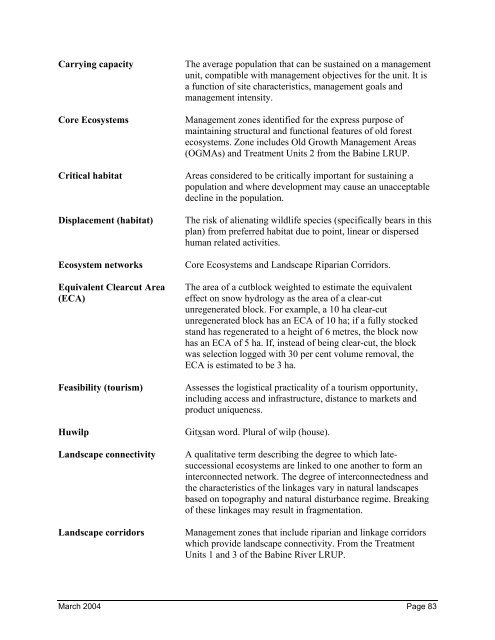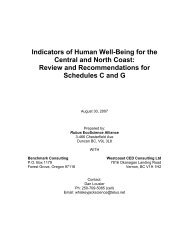West Babine Sustainable Resource Management Plan
West Babine Sustainable Resource Management Plan
West Babine Sustainable Resource Management Plan
Create successful ePaper yourself
Turn your PDF publications into a flip-book with our unique Google optimized e-Paper software.
Carrying capacity The average population that can be sustained on a management<br />
unit, compatible with management objectives for the unit. It is<br />
a function of site characteristics, management goals and<br />
management intensity.<br />
Core Ecosystems <strong>Management</strong> zones identified for the express purpose of<br />
maintaining structural and functional features of old forest<br />
ecosystems. Zone includes Old Growth <strong>Management</strong> Areas<br />
(OGMAs) and Treatment Units 2 from the <strong>Babine</strong> LRUP.<br />
Critical habitat Areas considered to be critically important for sustaining a<br />
population and where development may cause an unacceptable<br />
decline in the population.<br />
Displacement (habitat) The risk of alienating wildlife species (specifically bears in this<br />
plan) from preferred habitat due to point, linear or dispersed<br />
human related activities.<br />
Ecosystem networks Core Ecosystems and Landscape Riparian Corridors.<br />
Equivalent Clearcut Area<br />
(ECA)<br />
The area of a cutblock weighted to estimate the equivalent<br />
effect on snow hydrology as the area of a clear-cut<br />
unregenerated block. For example, a 10 ha clear-cut<br />
unregenerated block has an ECA of 10 ha; if a fully stocked<br />
stand has regenerated to a height of 6 metres, the block now<br />
has an ECA of 5 ha. If, instead of being clear-cut, the block<br />
was selection logged with 30 per cent volume removal, the<br />
ECA is estimated to be 3 ha.<br />
Feasibility (tourism) Assesses the logistical practicality of a tourism opportunity,<br />
including access and infrastructure, distance to markets and<br />
product uniqueness.<br />
Huwilp Gitxsan word. Plural of wilp (house).<br />
Landscape connectivity A qualitative term describing the degree to which latesuccessional<br />
ecosystems are linked to one another to form an<br />
interconnected network. The degree of interconnectedness and<br />
the characteristics of the linkages vary in natural landscapes<br />
based on topography and natural disturbance regime. Breaking<br />
of these linkages may result in fragmentation.<br />
Landscape corridors <strong>Management</strong> zones that include riparian and linkage corridors<br />
which provide landscape connectivity. From the Treatment<br />
Units 1 and 3 of the <strong>Babine</strong> River LRUP.<br />
March 2004 Page 83

















